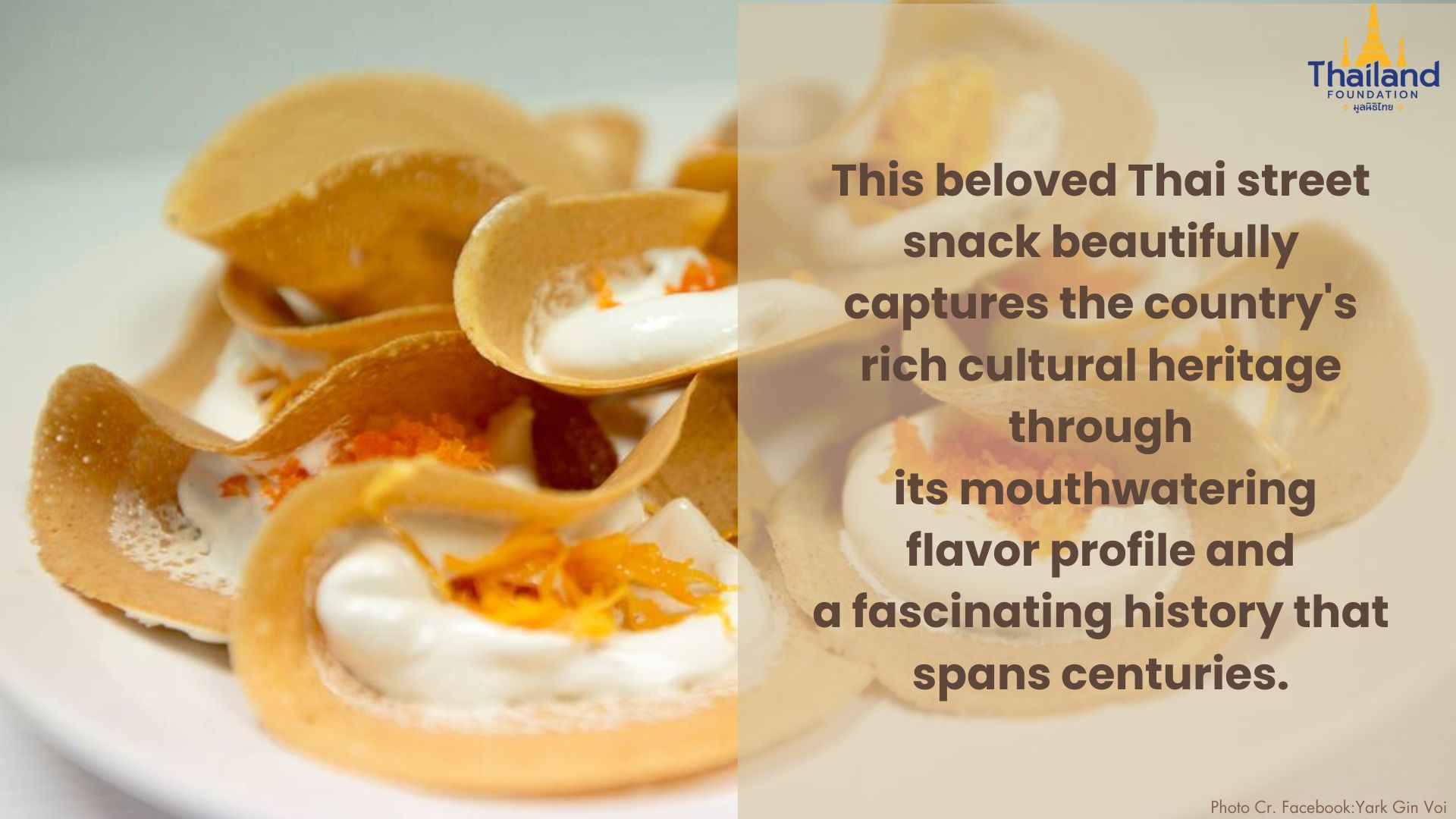
When visiting Thailand, you might notice a distinctive street treat: small, folded, crispy shells filled with white cream and topped with vibrant yellow or orange garnishes. At first glance, foreigners often mistake these treats for mini “tacos.” But with just one bite, many are surprised to find a sweet flavor profile, balanced by a combination of saltiness and nuttiness. This is khanom bueang, a cherished and timeless favorite among Thai people. With a history that spans centuries, khanom bueang is not just a snack, but also a cultural symbol passed down through generations.
Today, the Thailand Foundation invites you on a journey to discover the fascinating story behind this beloved treat, from its humble beginnings to its role as a culinary icon on the bustling streets of Thailand.
What is Khanom Bueang
Khanom Bueang (ขนมเบื้อง) is a traditional Thai street snack with a distinctive appearance and flavor. It consists of a small, crispy, golden-brown shell that is folded in half. Inside, the shell is filled with a creamy topping, typically made from whipped egg whites or coconut cream. The topping can vary between sweet and savory flavors. The sweet version is often adorned with vibrant foy thong (ฝอยทอง – sweet golden threads made from egg yolk), while the savory version may feature ingredients like minced shrimp, shredded coconut, or coriander.
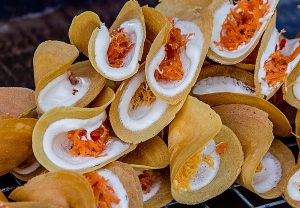
Khanom Bueang
Cr. kapook
The texture of khanom bueang offers a delightful contrast. The shell is thin and crispy, providing a satisfying crunch with each bite, while the cream filling is soft and rich, adding a smoothness that complements the crispiness. Depending on the recipe, other toppings can be included, such as chopped nuts or dried fruit, creating even more variety in flavor and texture.
In terms of taste, khanom bueang perfectly balances sweet, salty, and nutty elements. The creaminess of the filling blends with the crispy shell, resulting in a snack that is as complex as it is delicious. Whether sweet or savory, this treat offers a harmonious mix of flavors that make it a beloved favorite among both locals and visitors in Thailand.
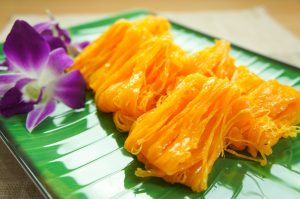
Foy thong
Cr. jamemy
History
The history of khanom bueang traces back centuries and is believed to have been introduced to Thailand by Brahmins from India, alongside the spread of Buddhism and Brahmanism into Southeast Asia. The dish itself has deep roots in Thai culture, with references to it found in ancient texts and art. For example, historical records describe the preparation of khanom bueang in temples during the Sukhothai period, and it is mentioned in the ancient literary work, Dhammapada (ธรรมบท), where a wealthy man named Kosiyah greedily hoards the dish, only to be taught a lesson in generosity by the monk Moggallana, a chief disciple of the Buddha.
The name khanom bueang is thought to originate from the practice of spreading the batter onto hot tiles, resembling the process of making pancakes. Evidence of its antiquity is found in the Ayutthaya era, where it is referenced in literary works like Khun Chang Khun Phaen (ขุนช้างขุนแผน). In this epic, two characters, Nang Sri Mala and Nang Soi Fa, are depicted competing in a khanom bueang making contest. This highlights not only the dish’s historical significance but also its deep connection to Thai culture and tradition.
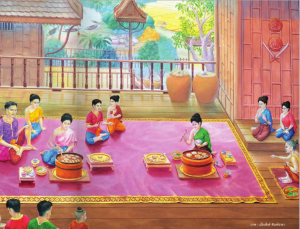
Khanom bueang making contest in ‘Khun Chang Khun Phaen’ (ขุนช้างขุนแผน)
Cr. วารสารวัฒนธรรม
By the time of the Rattanakosin period, khanom bueang had become an integral part of royal ceremonies and festivities. Historical documents from the reign of King Rama III recount its inclusion in royal feasts, particularly during significant celestial events. The dish was also associated with mastery in the kitchen, as ancient Thai society believed that a skilled woman should be able to make traditional sweets like khanom bueang, symbolizing her readiness for marriage and homemaking. Today, this connotation between khanom beuang with womanly has skills disappeared, perhaps due to the commercialization of the treat as well as changing social values.
Over time, khanom bueang evolved, with regional variations emerging. In the central plains of Thailand, where it is most commonly found, the traditional recipe called for rice flour mixed with coconut milk and seasoned with salt. As the dish adapted, fillings like shrimp and coconut were introduced, reflecting the abundant natural resources of the region.

Shrimp-filling khanom buean
Cr. wongnai
In 2013, khanom bueang was officially recognized as an Intangible Cultural Heritage of Thailand by the Department of Cultural Promotion, Ministry of Culture. This acknowledgment highlights its importance not only as a beloved snack but also as a symbol of Thailand’s rich culinary traditions. Today, while khanom bueang is found in many street markets, the traditional methods of preparation have been preserved by vendors, ensuring that this treasured snack continues to be passed down through generations.
Recipe for Khanom Bueang
Khanom Bueng is usually prepared in large batches. Thus, the recipe below will be for a large batch of khanom bueang.
Ingredients
-
- For the batter:
- 3 cups of rice flour
- 1 cup of finely ground roasted mung beans
- 2 eggs
- 2 cups of lime water (clear water left after soaking lime)
- ½ cup of sugar
- For the batter:
-
- For the sweet cream filling:
- 1 egg white (from a duck egg)
- 400g of palm sugar
- For the sweet cream filling:
-
- For the savory filling:
- 1 tablespoon finely chopped coriander roots
- 5 garlic cloves
- 1 teaspoon ground white pepper
- 1 cup grated fresh coconut
- 2 teaspoons salt
- 4-5 tablespoons sugar
- ½ cup finely chopped shrimp
- Orange food coloring (optional)
- A little cooking oil
- For the savory filling:
-
- For the sweet filling:
- 2 cups foy thong (sweet egg threads)
- ½ cup white sesame seeds
- 2 cups grated mature coconut
- For the sweet filling:
Cooking Instructions
-
- Prepare the batter:
- Mix the rice flour, ground mung beans, sugar, and eggs in a bowl. Slowly add the lime water while kneading the mixture until smooth. Continue kneading for about 10 minutes until everything is well combined.
- Make the sweet cream filling:
- Whisk the duck egg white with the palm sugar until it becomes a thick, white cream.
- Prepare the savory filling:
- Pound the coriander roots, garlic, and pepper together until smooth.
- Heat a little oil in a pan and fry the pounded mixture until fragrant. Add the grated coconut and shrimp, stir until cooked, and then season with salt and sugar. If desired, add a small amount of orange food coloring for a more vibrant look.
- Cook the khanom bueang:
- Heat a flat griddle and spread the batter into thin circles about 2 inches in diameter. Let the batter cook until it becomes opaque and slightly crispy.
- Spoon the cream filling over the top of the batter and spread it around the edges. For the savory version, add the shrimp mixture and top with a coriander leaf. For the sweet version, add foy thong, sesame seeds, and grated coconut.
- Once the edges are crispy, fold the khanom bueang in half and serve.
- Prepare the batter:
This basic recipe is recommended by the Department of Employment and will make between 700 – 800 pieces of khanom bueang, which is suitable for those looking to sell the treat or host a large gathering. The recipe can be adjusted to preferred serving size.
Values Behind a Favorite Treat
Khanom bueang is more than just a dessert; it is a reflection of the openness and adaptability that defines Thai culture. Throughout its long history, this treat has adapted from different influences, seamlessly blending foreign elements with local ingredients and techniques. This adaptability demonstrates the Thai people’s willingness to embrace new ideas while maintaining their cultural heritage, making khanom bueang not just a delicious snack but a symbol of Thailand’s unique ability to blend different traditions into something distinctly Thai.
In addition to showcasing cultural adaptability, khanom bueang also reflects the culinary skills of the Thai people. The delicate balance of flavors, from sweet to savory, demonstrates the Thai mastery of combining surprising flavors into a harmonious whole. The contrasting textures of the crispy shell and the creamy filling highlight the Thai love for creating dishes that engage all the senses, turning a simple treat into an experience of culinary artistry. This delightful contrast and balance in khanom bueang make it not only a beloved dessert but also a testament to the culinary ingenuity that characterizes Thai cuisine.
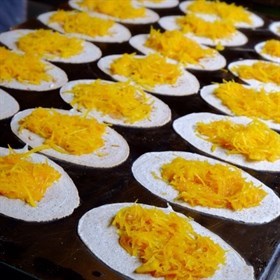
Cr. th.openrice
Conclusion
Overall, khanom bueang is beloved not only for its delicious taste but also for the rich cultural history and culinary artistry it represents. Its unique combination of crispy texture, creamy filling, and a blend of sweet or savory flavors makes it a treat that is both familiar and surprising. As one of Thailand’s beloved street food menus, it stands as a symbol of the country’s ability to adapt and innovate while honoring its traditions. If you ever have the chance to visit Thailand, don’t miss the opportunity to try this delightful snack and experience a piece of Thai culture firsthand. From bustling street markets to quaint stalls, khanom bueang offers a taste of the warmth and creativity that makes Thai cuisine so special. The Thailand Foundation invites you to savor this iconic treat and discover the flavors that have made it a timeless favorite.
The story of “Khanom Bueang” is a delectable aspect of Thai Culture and Heritage. The delightful blend of textures and flavors of this beloved treat demonstrates the remarkable culinary skills that have been passed down through generations, while its intriguing history that reflects the adaptability and ingenuity of the Thai people. Join us in exploring more stories of Thailand and its people, as we take you on a journey to discover the essence of Thainess.
*This article was written with the help of AI.
◊◊◊
Sources:
- Watthanatham Journal, Department of Cultural Promotion (history of khanom bueang)
- Department of Employment (khanom bueang recipe)
https://www.doe.go.th/prd/assets/upload/files/vgnew_th/7f620e49dedd44081d84ad2078e14815.pdf
Author: Tayud Mongkolrat
26 September 2024




